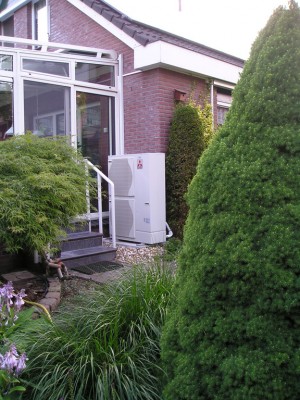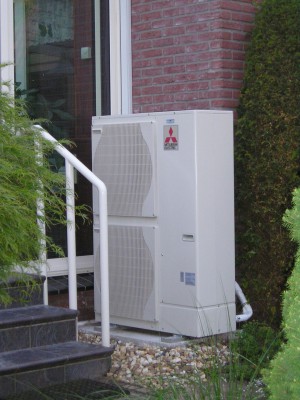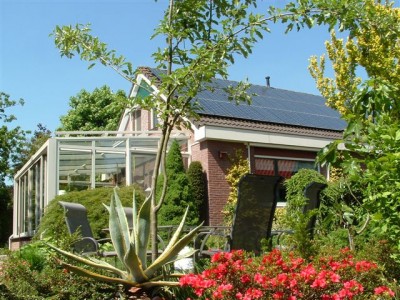Existing home in the Netherlands, converted to zero energy
Posted by Zwerius Kriegsman in Energy saving, Solar energy 19 Comments» As far as I know, this is the first existing home in the Netherlands, which is converted to a “zero energy” home. The electricity generated by solar panels and the heating is done by a heat pump, total net costs of subsidies: € 15,000.
As far as I know, this is the first existing home in the Netherlands, which is converted to a “zero energy” home. The electricity generated by solar panels and the heating is done by a heat pump, total net costs of subsidies: € 15,000.
Solar energy
The electricity is generated by (15.5 kWp) solar panels (Kyocera) and converted to 230V AC through inverters (SMA). Half of the panels face east and the other half face west. The annual average yield is about 10,500 kWh. Summers electricity surplus is supplied to the grid, and in winter the deficit is supplied by the grid. It works great. You don’t even notice. It is now regulated, that the first 5000 kWh per year can be exchanged with the grid for free. This means that for the first 5000 kWh we supply to the grid, we cash the same amount as what we have to pay per kWh (including network costs, environmental tax and federal tax!). We have enough electricity in one year for normal consumption ( light, washing, TV, computer, etc.). and for the heating + hot water. Oh yes, and cooking is done with an induction plate.
No alternative lifestyle
We don’t live an “alternative” lifestyle with all sorts of restrictions, but do everything most of us do. Our normal annual consumption for TV’s, fridge (2x), freezer, washing machine, (heat pump) dryer, dishwasher, computers, etc, etc. is about 5000 kWh, which is even slightly above the Dutch average annual consumption of 3600 kWh. Of course we paid a little attention to the equipment we purchased (energy-consumption). Like a freezer with A++ energy label (=Dutch rating). Heat pump clothes dryer etc.
Heating
Heating + hot water are provided by an air / water heat pump (Mitsubishi Zubadan). The energy consumption for the heat pump for heating and hot water is about 5500 kWh / year (was about 2200 m3 gas / year). Of course, a heat pump only operates efficiently if the heat can be supplied at a low temperature level. That means for example (very) large baseboard heaters or radiant floor heating or wall heating. Fortunately, 22 years ago during construction of our house we had already taken into account, the possible application of a heat pump or solar energy. So our house was already fully equipped with radiant floor heating. The water supply temperature to the floor is about 35°C at -10°C outside temperature. So, great for a heat pump. The PV installation is now 5 years old and bought under the old (good!) grant scheme. The heat pump is installed (again with € 1000, – grant).

The Air/Water Heatpump located next to the House
The design of the installations was done by myself. I also took care of the installation. Only the cooling section of the heatpump was installed by a certified company (obligation because of R410A).

The Air/Water Heatpump in detail
Investment
The total cost of the PV installation + heat pump is around € 15,000. These are the costs after deduction of the grants. It is easy to see, that with former monthly gas and electricity bills of approximately € 210, sustainable in this way is not “expensive”, but quickly payed back.






19 replies on “Existing home in the Netherlands, converted to zero energy”
Experts agree electric radiant floor heating is one of the best ways to heat a home on a number of levels. When energy efficiency, cost effectiveness, environmental cleanliness and conservation come into play, radiant heating systems can do it all.
Electric radiant heat is more effective than standard baseboard heating. Most of the time it’s also more efficient than forced air heat. The big advantage is that no energy is lost through the heating ducts in the home. The heat goes to where it is most required and keeps a room toasty warm.
While most electric heating systems distribute heat by circulating warm air throughout a room, electric radiant floor heat takes a different approach. By warming surfaces to directly heat objects and, therefore, people in your home, this heating alternative is gaining popularity by the day.
I don’t know which experts you are referring to, but any electric heating based on electrical resistance heating is wasteful as you surely know.
There are some applications where the situation can be such that resistance heating can be a solution, but in general it’s not the way to go.
Heatpumps are different of course.
Wonderfull information. Exites me, since I am also planning to have an energy efficient home here in South Africa: plenty of sun.
Would like to have more info on the inverters and heat pump
@ Hans Lodder:
The inverters we used are SMA2100TL. Solar Panels are Kyocera KC125G-2.
Th heatpump is an air to water heatpump, which heats up the water in our radiant floor heating system, but also (through a 3-way valve) our domestic hot water boiler (100 liter).
The heatpump is a Mitsubishi Zubadan. We have a system with a heating capacity up to 11 kW (at -15°C outside temp.).
It’s an invertertype, so produced heatingpower is depending on demand.
Type is PUHZ-HRP100YHA2 with controller PAC-IF021B-E and plate heat exchanger Alfa Laval ACH70X-50H.
Hope this is enough information…
Dear Zwerius ,
A very impressive performance of great interest . The average Dutch annual consumption of 3600 kWh is remarkably low – must be very careful people in Holland ! You are lucky with your subsidies and net-metering feed-in to the grid . Here in Cape Town South Africa we have no subsidies at all and no possibility to feed in to the grid yet, so we have to put in batteries . I have installed a 3.8 kWp PV system with batteries (cost about Euros22000) and am running a solar powered home . We do have sunshine , and I anticipate my panels will produce around 6000 kWh per year (have been running 7 months now) with house consumption of about 3600kWh per year . Hot water comes from solar water heating . Keep up the good work . Thanks .
I set the system Zubadan in Russia. Experience in the use of such systems have little.
Please answer a few questions:
1. At what minimum outside temperature of the system works Zubadan.
2. Your system only works on hot or combines also feature air-conditioning?
3. What are your overall impressions of the operating system, possibly during the operation there were problems that should be considered in new installations.
I really hope to answer. Thank you.
Hello Sergey,
As far as I know, the Zubadan keeps it’s power constant to -20°C ambient.
However it can operate to as low as -25°C ambient (with a little reduction of the heating power).
However the maximum temperature that can be achieved is:
above -3°C ambient: watertemperature max. 60°C
at -15°C ambient: watertemperature max. 55°C
below -17°C ambient: watertemperature max. 47°C
I use the system only for heating (including domestic water heating), but it is possible to use it for cooling too.
I’ve had only minor problems so far.
The COP over 2010 (over the whole year incl. domestic water heating) was 3.2
However I have made an addition/change to the system, which raised the COP to values well above the Mitsubishi specs.
I’m in the proces of a patent application at the moment.
Hello Zwerius,
thanks for the info.
I hope you’ll have to get a patent and our world will become even more perfect.
Good day Zwerius Kriegsman.
there was another question I want to get a response from a specialist.
When working on heating systems Zubadan at negative outside temperature is how relevant the problem of freezing of the external unit. How often the system is switched to the defrost mode?
I hope to answer. Thanks.
Good afternoon, Zwerius Kriegsman
wanted to know how to move your business to obtain a patent for an improvement of the heat pump. May already have some or publicly available information.
Sergey.
Hello Sergey,
No, sorry.
No information available yet.
The application for a patent takes a long time (can even be up to one year!)
In the meantime (now is autumn 2011), we can exchange with the grid without limits.
So I get the same amount of money (including taxes) for the energy I sell/buy to/from the grid.
Zwerius
Hi,
I was searching for more info about zubadan and found this website.
I’m interest to know if there are any news about the method (patent has described) to increse the cop and if its applied only to zubadan?
Thank you,
Carlos Morais
Hello Carlos,
Unfortunately, patent was granted, but doesn’t work.
It was based on faulty measurements. The kWh-meter I used, appeared to be defect.
It was a pitty.
Zwerius.
Thank you for the reply, unfortunatly doesn’t work.
I’m interested to buy a zubadan 14kw, i think its better than the similar daikin model.
How long time do you have yours? Do you recomend it? Is the maintenance expensive?
Regards
Carlos Morais
I have the 11 kW Zubadan.
I’ve had it for four years now.
I’m satisfied.
No expenses so far. So far, maintenance cost = 0
Regards,
Zwerius
Hi,
Thank you so much for the feedback.
Regards
Carlos Morais